#Hebrew Illuminated Manuscripts
Text
I'd like to introduce you to LJS 57, a compendium of Astronomical text in Hebrew, written in Spain around 1391. It's an interesting combination of astronomy and astrology, and illustrates how the division between "science" and "not science" was not nearly so clear in the past as it is today. It has some fantastic illustrations of constellations!
🔗:
#medieval#manuscript#medieval manuscript#14th century#hebrew#astronomy#astrology#stars#constellations#illustrations#illuminations#diagrams#history of science#book history#rare books
4K notes
·
View notes
Text

MAHZOR. (Tuscany, c1490) A Jewish holiday prayerbook. Gold highlights, initial word panels throughout in burnished gold on red, green or blue grounds, some embellished with marginal sprays, text illustrations Edges gilt and gauffered
Mid 16th-century Italian gold-tooled dark brown goatskin over thin wooden boards with strapwork painted in red and yellow, both covers with central cartouche with coat of arms, elaborately decorated with a unicorn and rabbit, hatched leaf and flower tools, solid dots and foliate rolls.

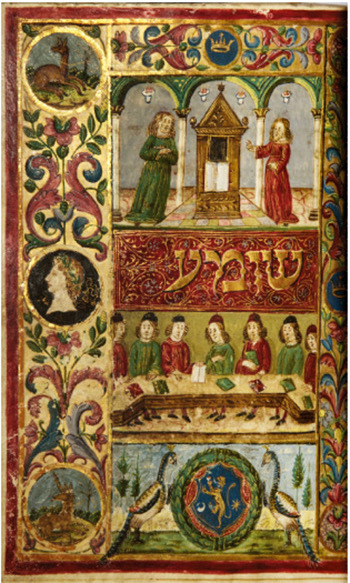
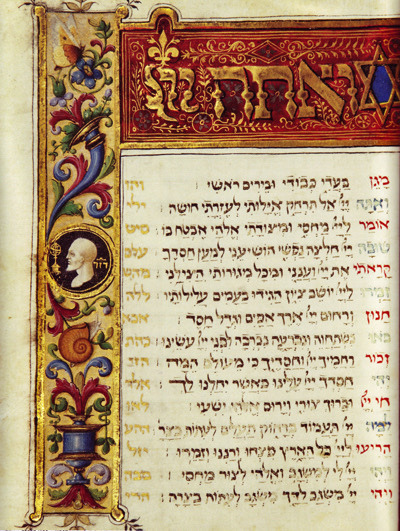

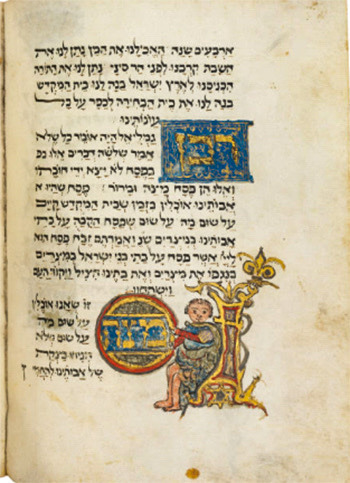

source
#beautiful books#book blog#books books books#book cover#books#vintage books#illustrated book#hebrew#mahzor#15th century#gauffered edges#illuminated manuscript#fore edge painting
55 notes
·
View notes
Text
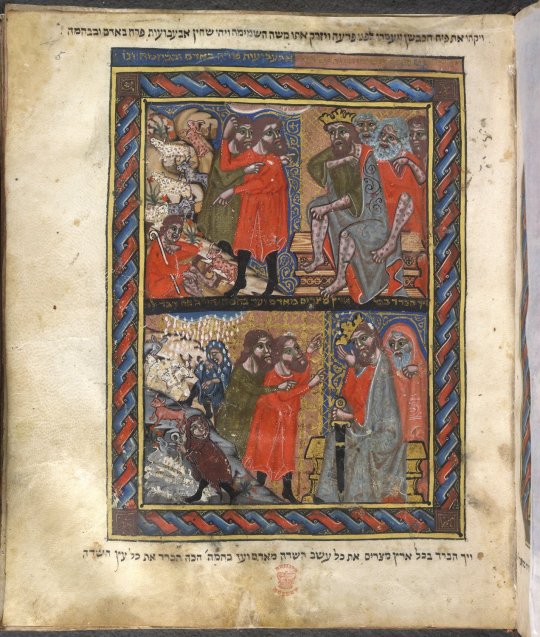
Folio 5 recto (The 6th & 7th plagues), the Brother Haggadah
#manuscript#illuminated manuscript#brother haggadah#haggadah#c: catalonia#c: shephardi#l: hebrew#y: 1300s#t: page
29 notes
·
View notes
Text

Unicorns and goats and elephants, oh my!
This elephant, in the center of a star of David, appears at the beginning of the Book of Deuteronomy (Devarim) in a highly illuminated copy of the Pentateuch made somewhere in the Holy Roman Empire between about 1300 and 1325.
Some scholars have argued that the artists of this manuscript derived the elephant symbol largely from the influence of Christian artists and writers (who in turn derived much of the symbolism from Late Antique and ancient writers). There are dragons higher up on the page, and the (satanic) dragon fighting the (steadfast and loving) elephant was a major theme in Christian bestiaries, patristics, and other works. However, in "The Elephant and the Law", Marc Michael Epstein argues that there were subtler meanings and that elephants had long-standing symbolism in Jewish art, too. (He points out that elephants do appear in a mosaic on a floor of a synagogue from about 530 AD).
Today, this manuscript is known as the "Duke of Sussex Pentateuch" because it was once owned by Augustus, Duke of Sussex, one of the sons of King George III and Queen Charlotte (of Bridgerton fame).
Date: 1300-1325
Origin: Holy Roman Empire
Now British Library, Add MS 15282, f. 238r

#elephant#elephants#medieval elephants#hebrew manuscript#pentateuch#dragon#unicorn#illuminated manuscript#book history#fourtheenth century
19 notes
·
View notes
Text
Episode 4: Michelle Margolis on Studious Women, Colorful Margins, and a Curious Bath

Folio 37v (not 40r!), men and women studying together.
In Episode 4 of Inside My Favorite Manuscript, Lindsey and Dot talk to Michelle Margolis about a 15th century Haggadah manuscript from Germany. We spend some time talking about how many women are present in the illustrations, and why that might be. We look at some of the other illustrations, which include a hunt, and a very interesting bathing scene. Finally we discuss the signs of use in the manuscript, including ones that you’ll only see in a book used at the dinner table.
Listen here, or wherever you find your podcasts.
Join our mailing list to receive weekly updates about the IMFM pod!
Below the cut are photos of some of the specific things we discuss in this episode.
University of Darmstadt, Cod-Or-8, Israel ben Meir, Pessach-Haggada. Heidelberg, [ca. 1430]
Folio 37v (not 40r!), men and women studying together.

Folio 5r, the blessing of the wine
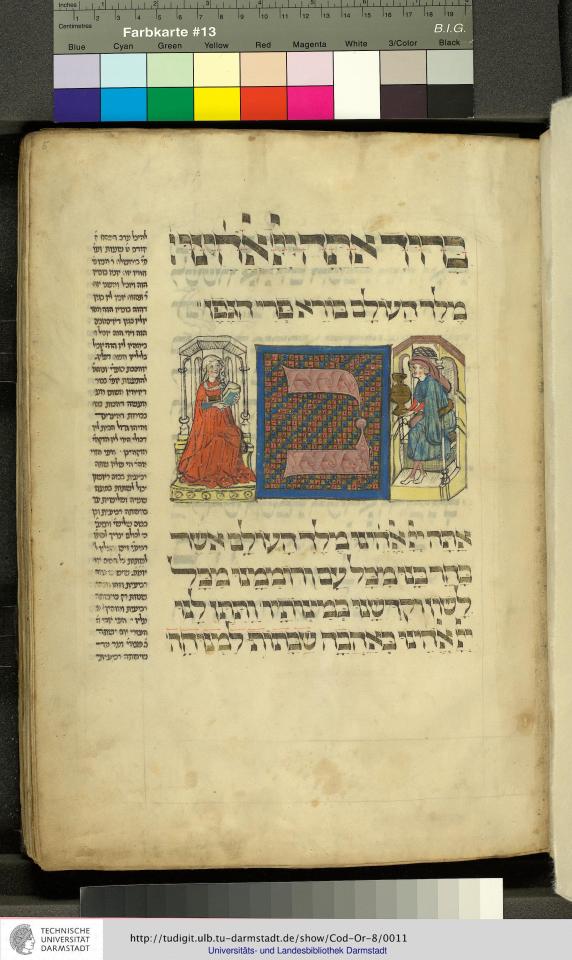
Folio 25v, with two initial letters

Folio 10v, the one with all the colorful critters

Folio 10v, close-up of the one that “looks like a bat that is also a flower”
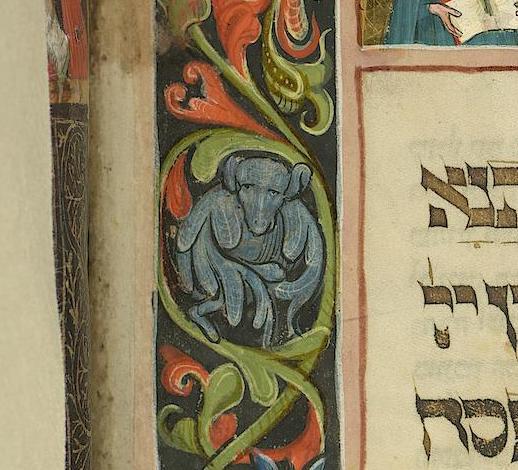
Folio 10v, close up. Is this a page (a boy) or a woman?

Folio 56v, the colophon, aka where the scribe, Israel ben Meir, wrote his name
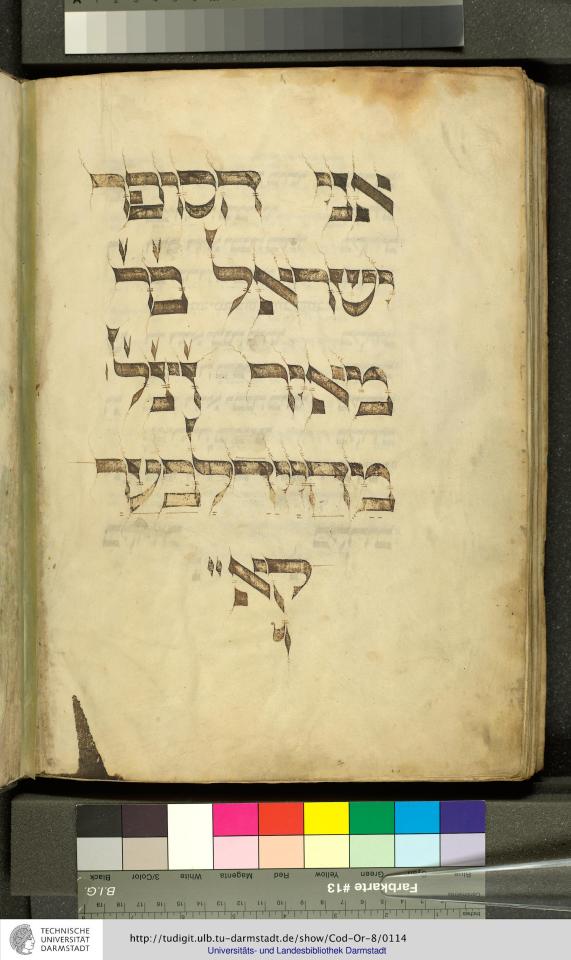
Folio 57v, the hunt

Folio 58r, bathing

Folio 51v, with birds and lions
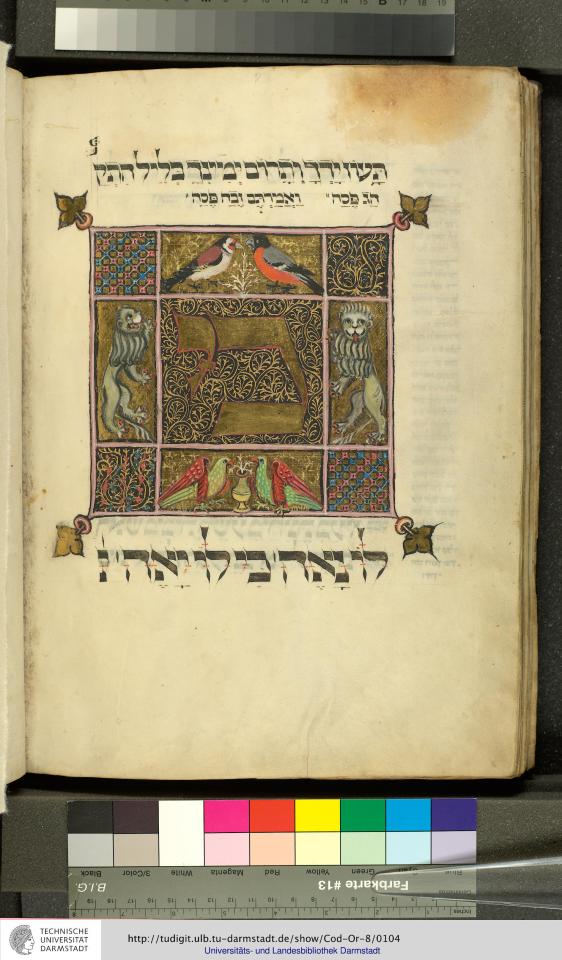
Folio 30r, which has been spilled upon

Folio 29v, which faces 30r and has also been spilled upon

Article about a project to analyze stains in manuscripts: Campagnolo, Alberto; Connelly, Erin; and Wacha, Heather (2019) "Labeculæ Vivæ: Building a Reference Library of Stains for Medieval and Early Modern Manuscripts," Manuscript Studies: Vol. 4: Iss. 2, Article 7.
Emma Stanford, “Booksquashing.” The Bodleian Libraries, July 31, 2018
Folio 37r, the other side, 37v, shown at the top of this post.

Folio 10r, the other side, 10v, shown further up in this post.
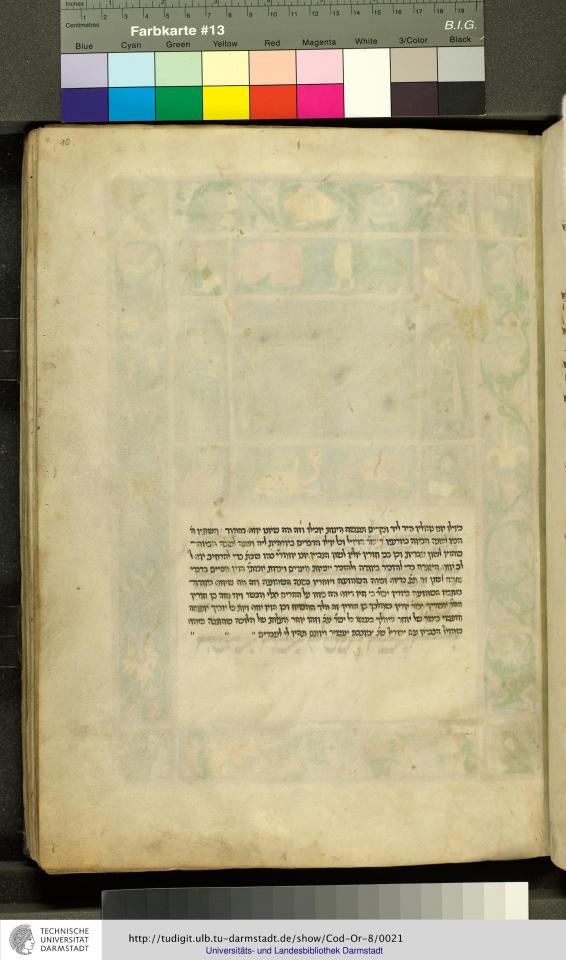
Front pastedown, inside front cover, with writing that has been erased.
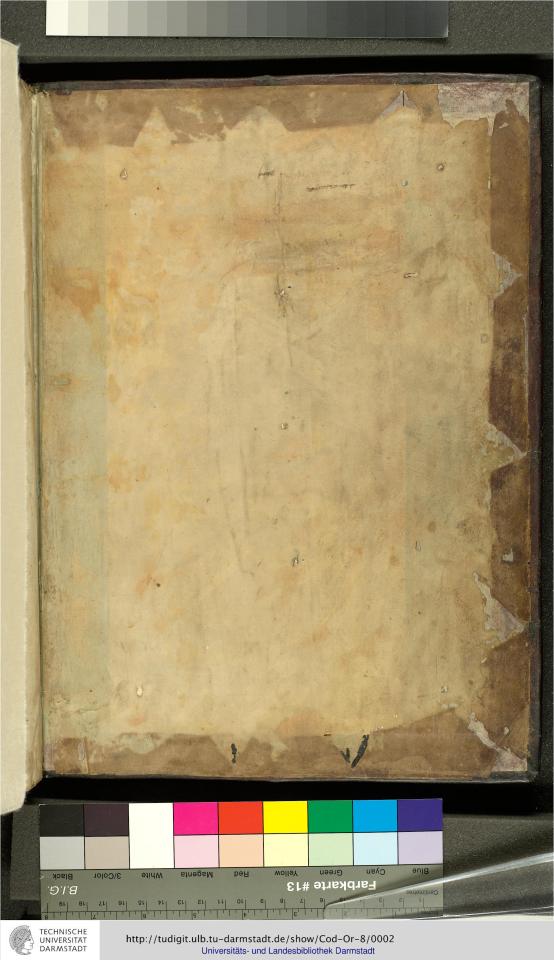
Close up of erased section
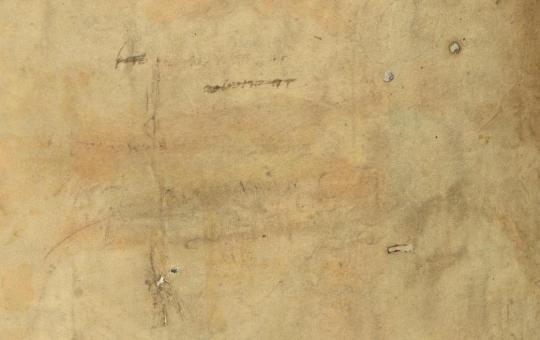
Back pastedown, inside back cover.

Folio 48v
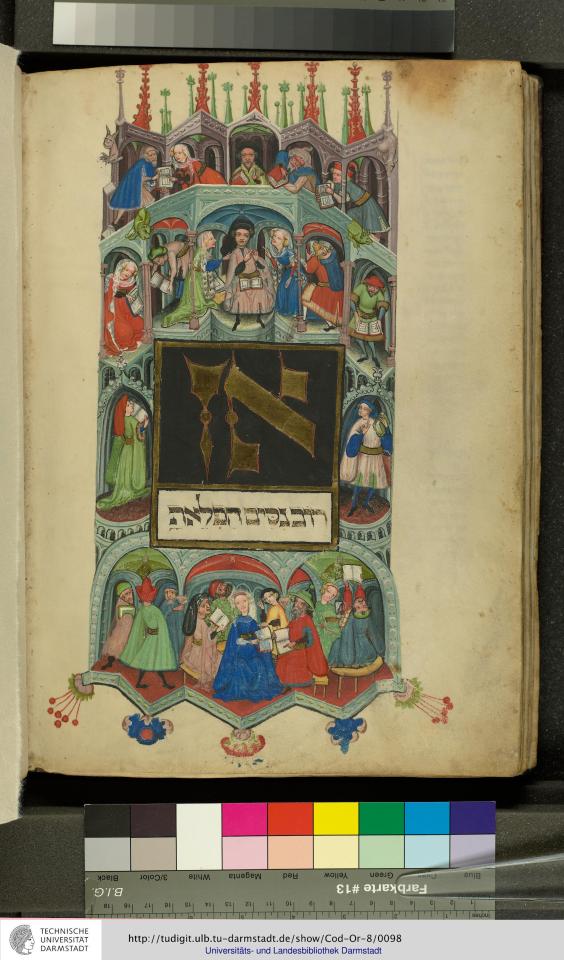
Folio 48v, close-ups. Woman surrounded by men looking at the reader, and a man who is very excited about his book.
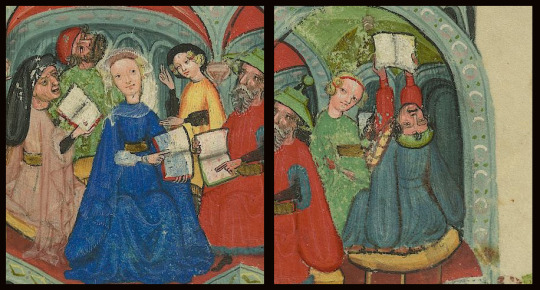
36 notes
·
View notes
Text

Song and dance
The word shir (song) flanked by a unicorn and a bear, from the beginning of the Song of Songs in an early 14th-century Pentateuch. Today, this manuscript is known as the Duke of Sussex’s Pentateuch after a later owner.
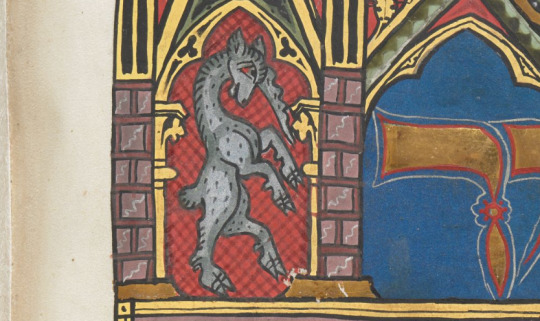
Date: c. 1300-1325
Origin: Holy Roman Empire?
Now British Library, Add MS 15282, f. 296v
#unicorn#medieval unicorn#manuscript#illuminated manuscript#illumination#hebrew#hebrew manuscript#jewish history#bear
5 notes
·
View notes
Text
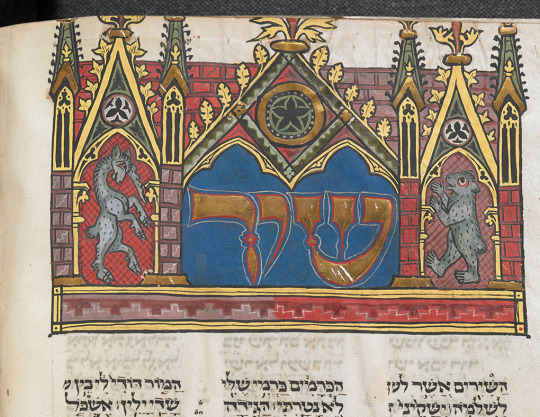
One day at the end of 1973, my parents and I visited the British Museum. I can’t remember a thing about what we saw there, except for what we came across after we decided to leave.
Getting out of the building involved making our way through a long series of connected galleries. We were just a step from leaving one to enter the next when the door was shut in our faces — and locked. We tried to go back the way we came, but that door, too, had been locked. Something was up.
With nothing else to do, I began looking at the gallery’s display cases. They were full of Medieval illuminated manuscripts.
I have a complicated relationship with the Middle Ages, as I have explained previously, but I love illuminated manuscripts, so I began making a systematic tour of the gallery. Well, all right, I was 12, so maybe it wasn’t all that systematic, but I do remember that I wanted to see everything! A few minutes into it, I came across something the likes of which I’d never seen, heard about, or even imagined: A display case full of examples — there must have been half a dozen — that were in Hebrew! I was astounded and overjoyed.
The British Museum Library’s collection is now part of the British Library, so those manuscripts are no longer housed where I saw them, but the BL has begun digitizing them, and all of the illustrations in this post can be accessed here. (Be warned: these files can take a long time to appear.) Truthfully, I don’t have specific memories of what I saw, but I do recall a lot of scarlet, azure, and gold, much like what you see at the top of this post. Of course, they’re not all in the same style:
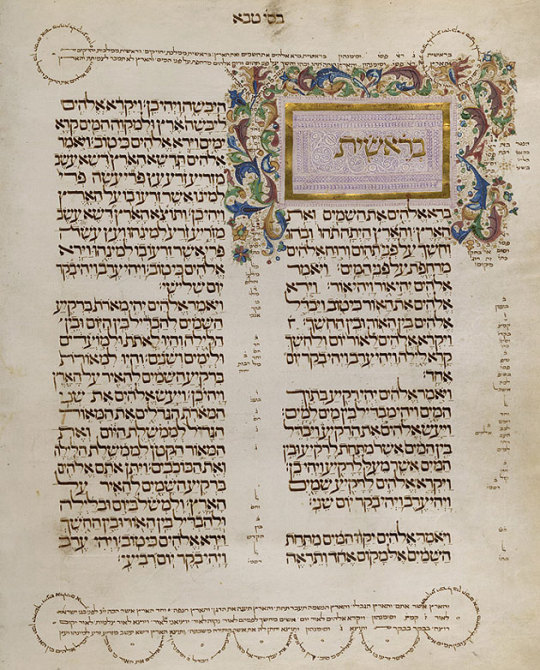
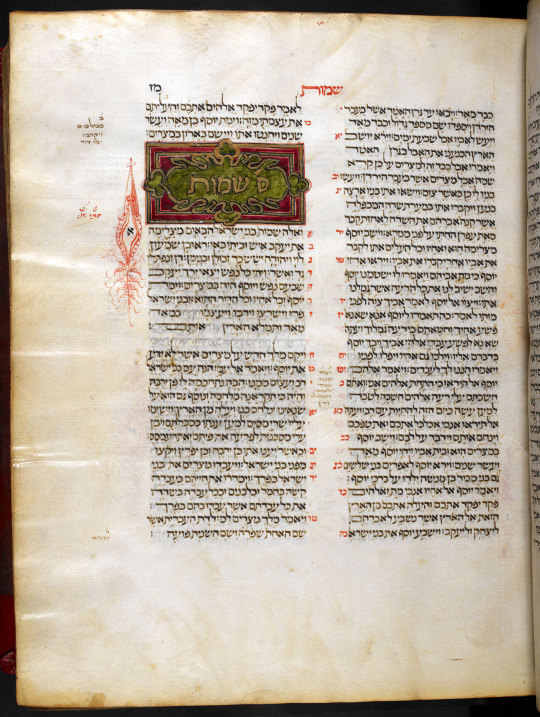


You’ll notice that in most of these examples, not just the first letter but the whole initial word is illuminated. That reflects the fact that Hebrew has no capital letters (or no lower-case letters, if you prefer).
Here’s an example of another type of Hebrew manuscript illumination:

This is an example of micrography, in which the text is arranged in a decorative pattern or is used to form an image. Although that’s a Greek word, I’ve never seen this done with any language other than Hebrew, Yiddish, Judezmo (Ladino), or Judeo-Arabic. It continues to be practiced to this day.
It always warms my heart when I see examples of these illuminations on my dashboard, and always brings me back to that unexpectedly exciting afternoon at the British Museum.
After about 45 minutes, the doors were unlocked and we left. It was 1973, so no prizes for guessing what led to the building being put into lockdown! It wasn’t our only encounter with the Troubles during that visit.
14 notes
·
View notes
Text
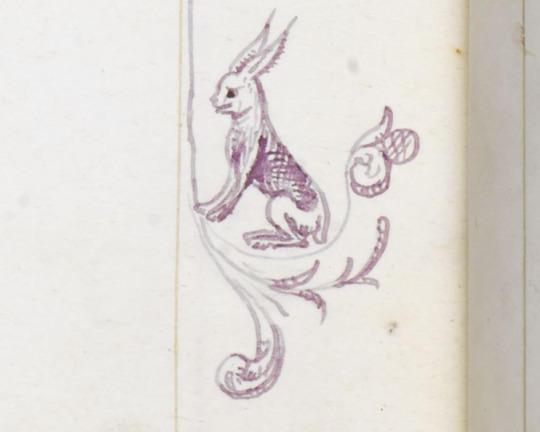
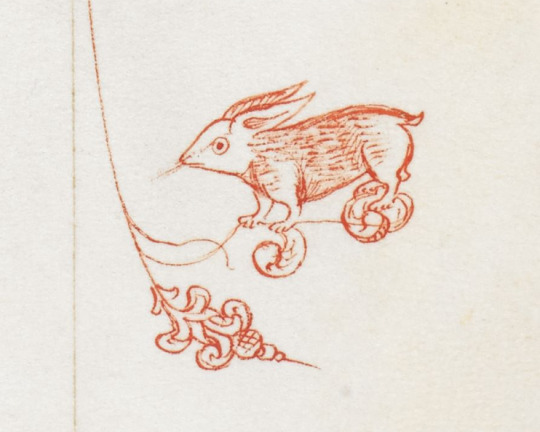

More art for #LunarNewYear #YearOfTheRabbit:
rabbits in the marginalia of a medieval Italian Pentateuch - BL Add MS 15423, Florence, 1441-1467 CE, in Hebrew, f. 7r, 41v, 140v. [British Library]
#rabbit#rabbits#mammals#illustration#book illustration#codex#medieval manuscript#illuminated manuscript#marginalia#Hebrew manuscript#Jewish manuscript#medieval art#European art#Jewish art#works on paper#Pentaeuch#Hebrew Bible#Torah#British Library#Lunar New Year#Year of the Rabbit#animals in art
10 notes
·
View notes
Photo
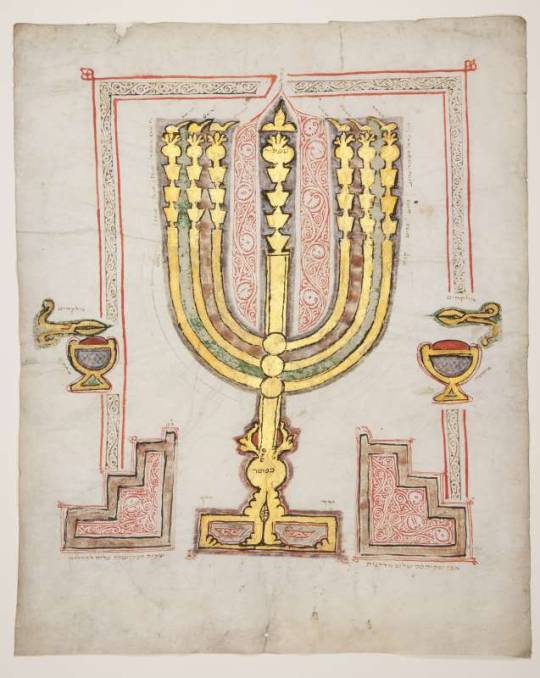
Illuminated leaf with an illustration of the Menorah. Spain, late 15th century.
Since the Temple’s destruction, depictions of its seven-branched candelabrum (Menorah) have served a symbol of the Temple and of redemption. Medieval Hebrew manuscripts contain many portrayals of the Menorah alongside other Tabernacle and Temple vessels. In Spain and Provence, these were especially profuse, and the Bible codex was sometimes called a Mikdashyah (God’s Temple). This single leaf, probably part of a manuscript, shows the Menorah symmetrically flanked by tongs, incense shovels, and the three-stepped stone on which, according to the Mishnah, the priest stood to trim the lamp.
145 notes
·
View notes
Text

The exact origin of the Kol Nidre melody is a bit of a mystery…
It's been claimed that the melody's roots can be found in German medieval folk music. Others have rejected this idea, arguing that it is clearly of Jewish origin.
There is, in fact, not just one Kol Nidre melody, but a collection of musical themes which came together and settled in a permanent order at some point during the 15th or 16th centuries.
The combination of the religious setting, the emotional backdrop, and the powerful melody creates a unique psychological atmosphere among those gathered to hear the prayer on Yom Kippur.
Much of this has to do with the ability of music to reach into the soul, even if the listener cannot understand the words. A few notes are often enough to trigger intense feelings and bring back old memories.
Over the centuries, the Kol Nidre melody has inspired countless musicians and artists, from classical composers to filmmakers to psychedelic rock bands.
See the first comment below to read on…
#YomKippur
The image below, an initial-word panel for the Kol Nidre prayer featuring decorative dragons and mythical beasts, appears in a Hebrew illuminated manuscript made in Germany in the early 14th century. It can be found at Oxford's Bodleian Library (MS. Mich. 619, fol. 100), zoom in here
National Library of Israel
37 notes
·
View notes
Note
The KJV is a bad translation?
the kjv is, as i understand it, a particularly poor translation for the modern english speaker. and probably not a great translation even for its day.
some of this is a historical problem. the kjv is a lightly edited revision of the bishop's bible; by the time it was put into print its language was already a hundred years out of date.
some of this is a time marches on problem: our understanding of the source texts and the number of manuscripts available to us to analyze is simply much better now than it was back when the kjv/bishop's bible/other early vernacular bibles were printed. not to mention our understanding of the historical context of those texts as furnished by, e.g., archeology.
some of this is a language marches on problem: "tabernacle" is from a Latin word meaning "small hut," which was probably a fine way to translate the hebrew word used for the dwelling place of god back in the sixteenth century, but now, thanks in part to its use in translations of the bible, basically only has a specialized religious meaning that obscures more than it illuminates when used in conservative translations of the bible. there are english-language turns of phrase in the kjv that are now consistently misunderstood just because standard english usage has changed sufficiently in the intervening centuries to alter the fundamental meaning of some passages.
and some of this is a dogma problem: there are passages in the bible that religious publishers with an agenda will insist on mistranslating because the plain meaning of the text is awkward for their particular dogmas. because of the role of the kjv in the second great awakening and american protestantism's fixation on this version of the text, there is the particular pathology of the "kjv-only" movement in american protestantism which insists that the kjv is not only fine, but is actually the best and only good translation of the bible and all the other english translations are corrupted by the devil or something, idk.
what translation of the bible is best probably depends on what you want to use the bible for (devotional purposes vs critical understanding of hte new testament vs critical understanding of the hebrew bible, etc.), but one can definitely do better than a translation published in the seventeenth century.
35 notes
·
View notes
Text

Every Thursday at 12pm EST / 5pm BST we host an informal lunch or coffee Zoom meeting (depending on your time zone) to visit virtually with Curator Dot Porter, onsite at the Kislak Center, and talk about one of the manuscripts from Penn’s collections. Each week Dot will bring out a manuscript (or two), do a show and tell and answer questions. Registration is required but the visits are open to everybody.
If you would like to receive weekly emails to remind you about upcoming Coffee With a Codex meetings, sign up for our email list here.
See the full schedule on our webpage.
Recordings of Coffee With A Codex since January 2022 are on our YouTube Playlist.
On September 14, curator Dot Porter will bring out LJS 41, a 15th century copy of the Book of Esther made it Italy, written on 3 gatherings removed from a miscellany.
12pm Noon ET on Zoom, everyone is welcome.
Register here: https://libcal.library.upenn.edu/event/11148405
#medieval#manuscript#15th century#hebrew#book of esther#italian#italy#medieval manuscript#illumination#illustration#event#zoom#book history#rare books
62 notes
·
View notes
Note
Hello friend! Just wanted to share some Jewish joy :) I converted almost 3 years ago and remember the journey well! Some friendly advice: keep a conversion journal as a place to put down your thoughts and feelings. It’s fun to look back on and create responses too!
Fun fact: in Jewish illuminated manuscripts (written in Hebrew), the entire first word is illuminated, rather than just the first letter. This is because it would profane the text itself to separate the letter from the rest of the word, and also show “favoritism” by singling out that one character as being better than others.
hello to you too, friend! thank you for the jewish joy, i hope you're having lots of it as well
a conversion journal actually sounds like so much fun, i'll definitely do that!!
and the fun fact is kinda cute whattt. very nice to be so thoughtful towards the letters. i wonder who came up with that or if it just has always been like that
9 notes
·
View notes
Text
The Byzantine scholiasts of Herodotus
“Why Herodotus is Worth Copying: The Scholia on Book 1
Simone A. Oppen
The scholia to Herodotus remain neglected (as discussed by Eleanor Dickey, 2007: 53-54), despite a general resurgence of interest in scholia (witness D. J. Mastronarde’s 2017 studies on the scholia to Euripides and the English translation of the scholia to the Iliad forthcoming from Cambridge University Press). The Herodotean scholia are comprised primarily, though not exclusively, of glosses (as noted by David Asheri, 1991: 241 and A. B. Lloyd, 1993: 211). Largely through close reading of the published scholia to Book 1 of the Histories, this paper makes the case that the interplay of glosses and other material preserved by the scholia illustrates a way of reading Herodotus distinct from that suggested by the Λέξεις Ἡρδότου (two glossaries, one arranged by order of appearance in the Histories, the other alphabetically) and other ancient scholarship focused on the historian’s dialect (such as the Περὶ Ἰάδος of Moschopulus).
Significant differences between the glosses in the Λέξεις Ἡρδότου and those in the scholia emerge early in Book 1. After glossing several words absent from the Λέξεις Ἡρδότου (ἀνακῶς, σπερχθείς, ἄτην, ᾖα, and περιημεκτέων as indicated by H. B. Rosén’s index, 1997: 456-67), the scholiast (or scholiasts) apostrophize the Lydian king Croesus:
σὺ μὲν ὦ Κροῖσε τῷ Δελφοῖς χρηστηρίῳ θαρρήσας κατὰ τοῦ Κύρου ἐξώρμησας· ὁ δὲ Κῦρος τὸν μέγιστον προφήτην Δανιὴλ μετακαλεσάμενος καὶ ἐρωτήσας καὶ μαθὼν ἐξ αὐτοῦ ὅτι σε καὶ ἡττήσει καὶ αἰχμάλωτον λήψεται, τὸν πρὸς σὲ συνεκρότησε πόλεμον, καὶ ὁ μὲν σοὶ δοθεὶς χρησμὸς ἐψεύσθη, ἡ δὲ τοῦ Δανιὴλ προφητεία ἠλήθευσε.
You, oh Croesus, having trusted in the Delphic oracle, set out against Cyrus. But Cyrus, having summoned the greatest prophet Daniel and inquiring and learning from him that he would defeat you and take you captive, waged war against you. And the oracle given to you was mistaken, whereas the prophecy of Daniel spoke truth.
(Greek text from Asheri, 1991: 242; translation my own in consultation with Asheri’s.)
This apostrophe suggests that the scholiast (or scholiasts) read, at a minimum, both Herodotus and the Hebrew Bible and sought to rationalize the two. Similar rationalizations, in the fullest collection of scholia to Herodotus gathered by Rosén, next occur at Book 1.153 and Book 2.44.5.
Later scholia on Book 1, however, indicate a more pervasive interest in the ancient Near East and again preserve material distinct from that in the Λέξεις Ἡρδότου. The scholia to 1.71.2 gloss ἀναξυρίς not as trousers (LSJ s.v. ἀναξυρίδες), but as a leather sandal first introduced by the Persians since earlier Greeks wore footwear of linen or wool (πρῶτοι δὲ Πέρσαι καταδεδείχασι τοιαῦτα, οἱ γὰρ Ἓλληνες τὸ πρὶν πεδίλοις ἐχρῶντο, ἅ οὐ σκύτινα, ἀλλὰ λίνεα ἢ εἴρινα). At 1.99.1 the scholia remark that customs established by Deioces are observed by Turks even now (τοῦτο καὶ νῦν φυλάττεται παρὰ τῶν Τούρκων; cf. scholia ad 1.135). The scholia to 1.125 connect the names Persian and Achaemenid to children born from intermarriage. These glosses are not idle but, together with material such as the apostrophe above, provide evidence that the scholiasts sought to guide future readers in using the text of the Histories as a source of knowledge about the ancient Near East relevant to their own historical moments.
In sum, this paper illuminates a part of the intellectual environment surrounding late antique and Byzantine readership of Herodotus. In so doing it makes a small contribution to our knowledge of the history of Herodotean readership. Parts of this history—whose lack was noted already by Felix Jacoby (1913: 504-5)—have been written by S. R. West (2011) and Olga Tribulato (2016). And yet their important work, focused respectively on the papyri of Herodotus and ancient Greek lexicography and grammar, has not specifically addressed the scholia preserved by the manuscript tradition, as this paper begins to do. Thus, this paper helps us to better understand some of the reasons why Herodotus’ monumental text remained relevant enough to readerly communities to merit copying.”
Source for this abstract of the paper: https://classicalstudies.org/why-herodotus-worth-copying-scholia-book-1

Simone Oppen, Assistant Professor at the College of Liberal Arts, University of Minnesota, specializes in Greek drama and historiography, in particular literary production under the Athenian Empire and its later reception (https://spanalumni.academia.edu/SimoneOppen/CurriculumVitae ).
2 notes
·
View notes
Text

The exact origin of the Kol Nidre melody is a bit of a mystery…
It's been claimed that the melody's roots can be found in German medieval folk music. Others have rejected this idea, arguing that it is clearly of Jewish origin.
There is, in fact, not just one Kol Nidre melody, but a collection of musical themes which came together and settled in a permanent order at some point during the 15th or 16th centuries.
The combination of the religious setting, the emotional backdrop, and the powerful melody creates a unique psychological atmosphere among those gathered to hear the prayer on Yom Kippur.
Much of this has to do with the ability of music to reach into the soul, even if the listener cannot understand the words. A few notes are often enough to trigger intense feelings and bring back old memories.
Over the centuries, the Kol Nidre melody has inspired countless musicians and artists, from classical composers to filmmakers to psychedelic rock bands.
See the first comment below to read on…
#YomKippur
The image below, an initial-word panel for the Kol Nidre prayer featuring decorative dragons and mythical beasts, appears in a Hebrew illuminated manuscript made in Germany in the early 14th century. It can be found at Oxford's Bodleian Library (MS. Mich. 619, fol. 100), zoom in here
National Library of Israel
17 notes
·
View notes
Text
Illuminated Manuscripts

“Christ Kneeling in Prayer in the Garden of Gethsemene” (c. 1475 France, Loire Valley)
Illuminated manuscripts embody the extraordinary union of beauty and knowledge.
Though the art of making them disappeared with the advent of the printing press, the most spectacular manuscripts survived the ages.
Here are 8 masterworks of medieval illumination: 🧵
1. The Morgan Crusader Bible, 13th century

Commissioned by French King Louis IX, the Morgan Crusader Bible depicts events from the Hebrew Bible set in the scenery and attire of 13th-century France — it puts a medieval twist on Old Testament stories.
Consisting of 46 folios, the manuscript displays illustrations accompanied by text written in either Latin, Persian, Arabic, or Hebrew.
The vivid colors and attention to detail make it one of the most popular illuminated manuscripts.
2. The Black Hours, 15th century
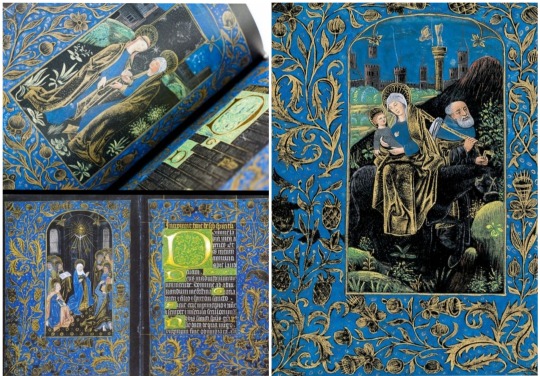
The Black Hours is a book of hours (a type of prayer book) created in Bruges, Belgium.
The style is in imitation of Wilhelm Vrelant, the most popular illuminator of the period and constructed of vellum (calfskin) that’s been dyed pitch black.
Gold and blue paint overlay the dark background to create an almost otherworldly look.
Written in silver and gold ink, the text lists the prayers to be said while depictions of Bible stories aid the reader in meditation.
3. Book of Kells, 9th century

Among the most iconic medieval manuscripts is the Book of Kells.
Created in a Columban monastery, the text is the pinnacle of early medieval calligraphy and illumination.
The graphics are a blend of insular art (the post-Roman era style of art popular in Irish monasteries) and traditional Christian iconography.
Plants, animals, Celtic knots, and biblical figures decorate the 680 page volume to tell the story of Jesus’ life.
4. Codex Argenteus, 6th century
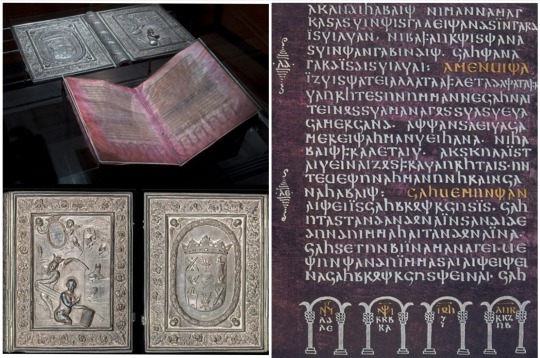
Latin for “Silver Book,” the Codex Argenteus contains the four gospels written in Gothic, making it one of the world’s foremost sources for the now-extinct language.
The book was likely written as a gift for Ostrogothic king, Theodoric the Great.
The work is particularly striking due to its purple-stained vellum pages, metallic ink, and silver binding. Looks almost Tolkienesque…
5. Acre Bible, 13th Century

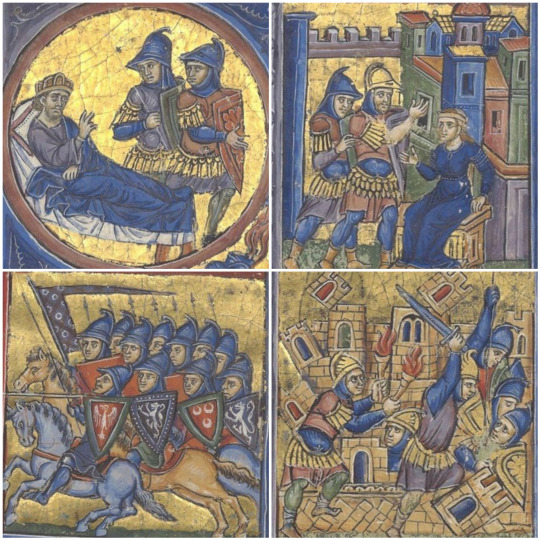
Another work commissioned by Louis IX, the Acre Bible was compiled shortly after the king’s release from captivity during the disastrous 7th crusade.
Upon returning to France, he deposited the masterwork in his newly built Sainte-Chapelle library.
It contains 19 books of the Old Testament, and its illustrations are considered masterpieces of crusader art.
6. The Aberdeen Bestiary, 12-13th century

A bestiary is essentially an encyclopedia of animals and mythical beasts.
They gained popularity throughout the Middle Ages as readers could learn about exotic animals or mythical creatures.
This one was owned by Henry VIII and features a retelling of the Genesis creation story with fantastical images of creatures both real and imagined.
7. The Very Rich Hours of the Duke of Berry, 15th century

The best surviving example of the International Gothic style of illumination, it’s one of the most lavishly designed late-medieval manuscripts and contains well over 100 illustrations.
Despite beautiful scenes covering most of its pages, the work didn’t shy away from darker imagery.
8. The Berthold Sacramentary, 13th century

Commissioned by the abbot of Weingarten Abbey, this manuscript is a form of missal called a sacramentary used by priests for liturgical services.
A sacramentary gives the priest's readings and prayers for the Mass. This one is a paragon of Romanesque art.
#illuminated manuscripts#medieval manuscripts#medieval illumination#Middle Ages#medieval period#art history#books#handmade books#scribe#illuminator#The Morgan Crusader Bible#The Black Hours#Book of Kells#Codex Argenteus#Acre Bible#The Aberdeen Bestiary#The Very Rich Hours of the Duke of Berry#The Berthold Sacramentary#Wilhelm Vrelant#King Louis IX#medieval calligraphy#Theodoric the Great#bestiary#Henry VIII#Weingarten Abbey#sacramentary#missal
1 note
·
View note